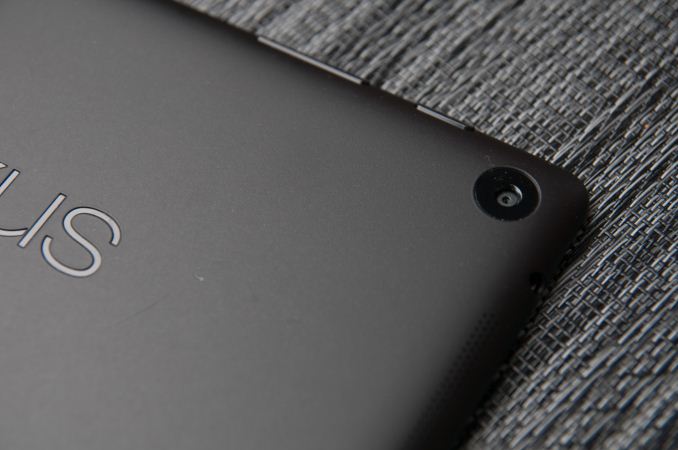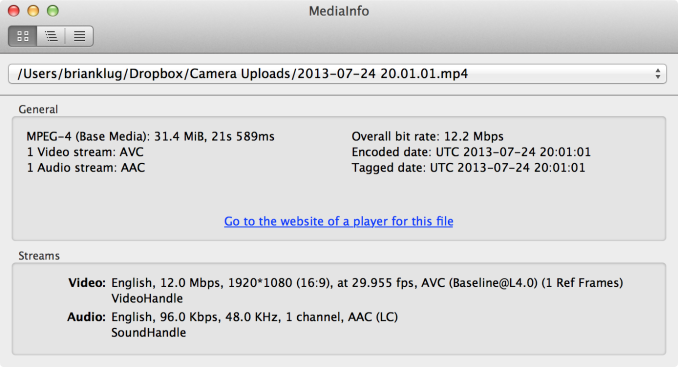Nexus 7 (2013) - Mini Review
by Brian Klug on July 27, 2013 12:54 AM EST- Posted in
- Tablets
- Snapdragon
- Qualcomm
- Android
- Mobile
- APQ8064
- Nexus 7
- Android 4.3
The lack of a rear camera on the original Nexus 7 was always a bit of a downer. It clearly had the space for a module inside, but including a camera didn’t align with the efforts to drive that device into the price point that made it successful. With the new Nexus 7 we finally get a camera, and a 5 MP one with autofocus at that. Inside the camera is an OV5693 sensor, which best I can tell is a 1/4" format sensor with 1.4 micron pixels. It might not be the world’s best camera, but it’s no slouch either.
I took a handful of photos and videos with the Nexus 7 (2013) to gauge camera quality, and even if this isn’t necessarily a device with focus on imaging it’s not bad at all. I came away pretty pleased for what kind of camera it is. Even though I still strongly believe that you shouldn’t be using a tablet to take photos you intend on using for anything more than sharing on social networks, in this brave new era of mobile devices it’s a feature every tablet and smartphone does need.
I’ll save you the discussion once again about how the Android 4.3 camera UI continues to present a 16:9 aspect ratio crop of the 4:3 image captured by the sensor, which results in a smeary looking, inaccurate preview.
Video on the Nexus 7 (2013) is 1080p30 at 12 Mbps, H.264 Baseline with 1 reference frame, and 96 kbps 48 KHz single channel AAC audio. I've uploaded a sample I took in SF to our servers as well as YouTube. Again I’m dismayed why more OEMs don’t use the full encode capabilities of APQ8064 (20 Mbps H.264 High Profile) but that’s what it is by default on the new Nexus 7.



















252 Comments
View All Comments
prince2013 - Saturday, July 27, 2013 - link
what is your basis that the LTE model doesn't include a Qualcomm RF360 chip? How else could it work with all US carriers?Brian Klug - Saturday, July 27, 2013 - link
RF360 isn't a chip at all, for some reason I see this all over the place. Rather it's a portfolio of front end components from Qualcomm with a stacked PoP (RF this time) architecture. The core of the RF360 family is a CMOS Power Amplifier and switch, the rest of it is just packaging. For reasons I've discussed, MDM9x15 family doesn't need "RF360" family font ends (of which there's only one compatible, it's primarily going to start with MDM9x25) to do Band 13 and 17 coexistence, just the right discrete PAs and filters, and there's plenty of space for that in a tablet.-Brian
nofumble62 - Saturday, July 27, 2013 - link
I don't see any compelling reason to upgrade my current Nexus 7 though.Dribble - Saturday, July 27, 2013 - link
Current N7 is still working fine, will skip thing gen and get V3 next year.easp - Saturday, July 27, 2013 - link
Is there a discussion of battery life I missed, or is that not relevant for mobile devices any more?Death666Angel - Saturday, July 27, 2013 - link
You've missed the headline, where it says "mini". He didn't have time to do the battery life tests, which take up most of such a review, as a single charge takes 2 to 4 hours and discharging them takes 5 to 10 hours most of the time.Brian Klug - Saturday, July 27, 2013 - link
Battery life testing is ongoing at present, Anand is running those as I write this.-Brian
EnzoFX - Saturday, July 27, 2013 - link
This may have been brought out by the tests, but is the display panel wide gamut? Or at least as much as the iPad 3/4 are?Vigneshj - Saturday, July 27, 2013 - link
//dismayed why more OEMs don’t use the full encode capabilities of APQ8064 (20 Mbps H.264 High Profile) but that’s what it is by default on the new Nexus 7//Can any third party android app helps to overcome this?
Brian Klug - Saturday, July 27, 2013 - link
Yeah or editing build.prop after you've rooted it to change settings.-Brian